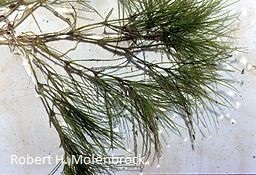
Ecological Importance
The entire bushy pondweed plant is eaten by waterfowl, especially mallards; provide cover for young largemouth bass, northern pike, small bluegills and perch. Submerged portions of all aquatic plants provide habitats for many micro and macro invertebrates.
Problems
Bushy pondweed has become more common in recent years; it can grow abundantly in some areas and cause problems. In most areas, it will not be a nuisance and is best left alone--removal may allow less-desirable plants to move in. When control is necessary, aquatic herbicides can be effective.
Plant Description
Leaves are narrow with tiny spines along the edges. Slightly enlarged at the base. Stems slender with frequent branching. Leaves oppositely attached, or in groups of two or more at a node. Leaves are densely concentrated at the tips.
Hints to Identify
Leaves are tapered to a fine point with tiny "spines"; seeds are shiny and smooth. Bushy pondweed is sometimes confused with chara, but chara has a musky odor when crushed and bushy pondweed does not.
Common Application Questions
Q. When is the best time to treat?
A. Plants must be present to treat. Water temperatures should exceed sixty degrees Fahrenheit.
Q. How often do I need to treat Busy Pondweeds?
A. One to two treatments per season is usually plenty.
Q. How long before I see results?
A. Generally within twelve to sixteen day things will be cleared up.
| Homeowner Treatment Options |
| Aquathol K |
| Aquathol Super K |
| Hydrothol® Granular |
| Sonar AS |
| Sonar RTU |
| *Aquatic Biologists recommends implementing preventative management techniques and physical removal prior to, or in conjunction with treatment. |
